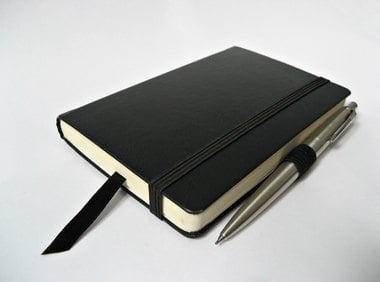I’m a few days late, but with the new year upon us, I’ve decided to inaugurate a new Moleskine. The old one is… well, it’s not good. The binding is broken, pages are out, and it’s just about full anyway. Plus, I’ve got a saucy new Moleskine in fire engine red that’s eager to get in the game. Since I make a big deal about using a Moleskine (or similar notebook) as an always-with-you productivity tool, I thought I’d share exactly how I set mine up. It’s not super-complicated, but it might give an idea of how a simple pad of paper can hold together all the strains of an insanely complex life. My strategy is simple: Make it as easy as possible to pull the thing out, use it, and put it away. No messing around to find the right section, no page numbers, nothing fancy. A few tabs, judicious use of the bookmark and elastic strap, and a good fine-tipped pen. And that’s it.
Making Sections
One of the greatest inventions of the 20th century was – ok, I overstate myself. Still, Post-It Index Tabs go with Moleskine notebooks like biscotti goes with coffee. Usually sold in assortments of three colors, these little plastic tabs are a little under an inch long and are coated on one end with Post-It sticky stuff so you can easily add tabs to any piece of paper or card stock. I use two per Moleskine. The first one goes a little past halfway into the book, the second about a dozen or so pages back from the end. That makes three sections:
1. Next Actions/Notes
The first section starts on page 1, so doesn’t need an identifying tab. This is an ever-growing list of next actions. I’ve tried using contexts in my paper to-do list, but it just gets in the way – I never know what to do with the next task after a page marked “@phone” or “@computer” is full. It certainly defeats the point to have to flip back and forth to find the right context to add a new task to. I used to have a separate section for notes, but I don’t anymore. What I do instead is this: tasks go on the right-hand page, notes on the left-hand page. And I do a lot of notes – I brainstorm post ideas, outline posts I intend to work on soon, jot addresses and phone numbers, draw maps and write directions, and on and on. There is one right-hand page that’s not for notes, usually the first one. This I designate for “Someday/Maybe”. I just don’t run into the same problem that contexts give me – running out of room on the page – because I guess I don’t use Someday/maybe all that much. In any case, I’ve never filled the page before needing a new Moleskine.
2. Projects/Goals
The first tab (which means the second section) is for projects. On the first page of the section, the one with the tab on it, I keep a running list of all the projects I’m working on. The next couple of pages are blank, so I can continue the list when the first page gets full. A few pages in, I start pages for each project, usually just lists of tasks and random ideas I want to remember. On the back of the first page, I write short-term goals. I have a simple formula: “By [DATE] I will have [GOAL]”. I typically set goals for 1 month, 3 months, and (maybe) 6 months in the future, so in this notebook, I’ll have something like “By February 15th, I will have…”, “By April 15th, I will have…” and (maybe) “By July 15th, I will have…” Then I revisit this page every so often to gauge my progress and set new goals.
3. Reference
The last section is for pieces of information I might need on the go: logins for my utilities, my Google Voice number (I can never remember it!), and other random but occasionally-useful stuff.
My Moleskine in use
My Moleskine lives in my back pocket. As I said, the goal is that when I need to us it, whether to check something, write down a task, or cross something off, it can happen instantly. Both the bookmark and the elastic strap are drafted into service of this primary goal. Usually, the sewn-in bookmark marks the first page under “Next actions” that I can write in, and the elastic strap is wrapped around the first blank page under “Projects”. If – and this happens very rarely – if the notes and tasks in the “Next actions” section get too far out-of-whack, whether because I’ve taken a bunch of notes recently and gotten several pages ahead of the last page of tasks, or vice versa, I’ll use the bookmark and strap to mark the last pages of tasks and notes separately. Although the Pilot G-2 is the time-honored companion to the Moleskine, my current favorite pen for my Moleskine is the Sharpie Retractable Fine-Point pen, a fat click-pen with a fiber-tip that lets me write super-small (thus maximizing the usefulness of a pocket-sized notebook). And that’s the whole system. Like I said, simple, but it works. And because it works with minimal effort, I actually use it. Every. Single. Day. Do you have any special tricks that help you get the most out of a pocket notebook? How do you set yours up? Let’s hear it!
